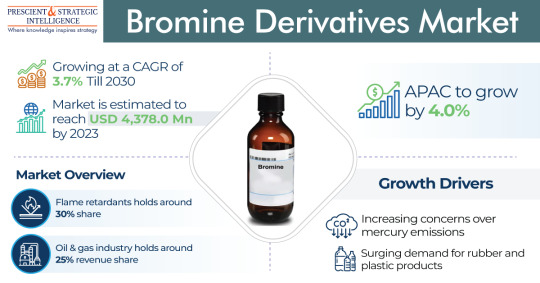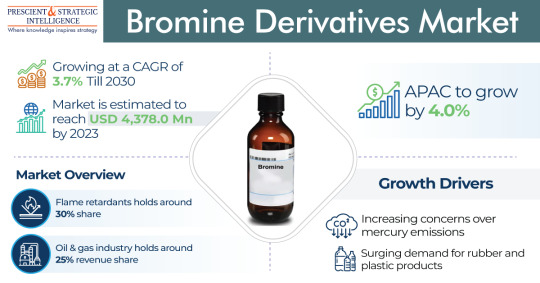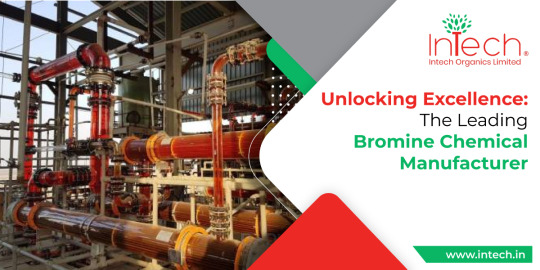#Bromine Derivatives Market Trends
Explore tagged Tumblr posts
Text
#Bromine Derivatives Market#Bromine Derivatives Market Trends#Bromine Derivatives Market Growth#Bromine Derivatives Market Research#Bromine Derivatives Market Report
0 notes
Text
Bromine Derivatives Market is expected to witness Incredible Growth

The bromine derivatives market refers to the global industry involved in the production, distribution, and sale of various chemical compounds derived from bromine. Bromine is a reddish-brown liquid element that belongs to the halogen group on the periodic table. It is widely used in various industries for its unique properties, such as flame retardancy, disinfection, and oxidation reactions.
Here is some full information about the bromine derivatives market:
Types of Bromine Derivatives:
Brominated Flame Retardants: These derivatives are widely used in the manufacturing of flame retardant materials, such as textiles, plastics, electronic components, and construction materials.
Organobromines: These compounds find applications in agriculture as pesticides, in pharmaceuticals as intermediates, and in the manufacturing of dyes, perfumes, and other chemicals.
Hydrobromic Acid: It is used in the production of inorganic bromides, as a reducing agent in various chemical reactions, and as a catalyst in organic synthesis.
Bromine Compounds: This category includes various bromine-based compounds like sodium bromide, potassium bromide, methyl bromide, ethylene dibromide, etc., which have diverse applications across industries.
Market Drivers:
Flame Retardant Regulations: Stringent regulations regarding fire safety standards in industries such as construction, automotive, and electronics drive the demand for bromine-based flame retardants.
Growing Chemical Industry: The expanding chemical sector, including pharmaceuticals, agriculture, and specialty chemicals, fuels the demand for bromine derivatives as raw materials and intermediates.
Water Treatment Applications: Bromine derivatives like bromine-based biocides are extensively used for water treatment in swimming pools, industrial cooling towers, and wastewater treatment plants.
Market Challenges:
Environmental Concerns: Bromine derivatives have faced scrutiny due to their potential environmental impact, particularly on human health and the environment. Regulations and public awareness regarding their safe use and disposal pose challenges to the market.
Substitution by Alternatives: In some applications, bromine derivatives face competition from alternative chemicals or technologies that offer similar properties with potentially lower environmental risks.
Market Trends:
Shift towards Sustainable Alternatives: With increasing environmental concerns, there is a growing trend toward developing and adopting sustainable alternatives to bromine derivatives, such as bio-based flame retardants and alternative water treatment solutions.
Technological Advancements: Research and development efforts focus on improving the efficiency and performance of bromine derivatives, as well as finding novel applications for these compounds.
Emerging Markets: Developing regions, particularly in Asia-Pacific, show significant growth potential for bromine derivatives due to expanding industrialization, infrastructure development, and increasing awareness of fire safety.
Key Market Players:
Albemarle Corporation
Israel Chemicals Ltd.
Tosoh Corporation
Gulf Resources Inc.
Lanxess AG
Tata Chemicals Ltd.
Chemtura Corporation
TETRA Technologies Inc.
Jordan Bromine Company Limited
Hindustan Salts Limited
Please note that the bromine derivatives market is dynamic and constantly evolving, so it is advisable to refer to the latest industry reports and updates for the most up-to-date information.
0 notes
Text
Bromine Derivatives Market Report: Demand Analysis, and Growth Forecasts | P&S Intelligence
The bromine derivatives market was USD 4,378.0 million in 2023, which will rise to USD 5,614.1 million, powering at a 3.7% compound annual growth rate, by 2030.This is because of the extensive use of these chemicals in the pharmaceutical, construction, oil & gas, electronics, and automotive sectors, coupled with the growing requirement for plastic & rubber products. Moreover, the calcium bromide…

View On WordPress
#analysis#Bromine Derivatives Demand#Bromine Derivatives Market#Bromine Industry#Competitive Analysis#Global Bromine Derivatives Market#Growth Forecasts#Industry Overview#industry trends#Market dynamics#Market Insights#market outlook#Market Report#Market Research#P&S Intelligence#regional analysis
0 notes
Text
Elemental Elegance: Navigating the Bromine Derivatives Market
Sodium bromide is the most demanded derivative of bromine. It is white-colored, highly volatile, crystalline solid similar to common salt. This salt is used for the use of the bromide radical. There are many applications of the same, just as the other derivatives of Bromine in the drug industry.
Some chemical compounds are called chlorides, halides, and iodides also get extracted while withdrawing from the water of the ocean. Antiepileptic properties of the bromide salts are unveiled within the other salts resultant ocean water.

Structuring of Sodium Bromide
Sodium is a positively charged, extremely unstable because it is an extremely reactive metal. So, this reacts with the negative bromide radical to form an ionic bond together for the formation of a sodium bromide compound.
The structure of sodium bromide is linear, and polar because the negative and positive radicals create a polarity where electrons are shared on the more negative radical, that is the bromide liberal in the compound.
Where they Use sodium Bromide?
Just as any other bromides, it is put to use as a sedative. In numerous health problems, such as insomnia, sedatives come good for curing the same.
In the oil and gas drilling sector, sodium bromide is the main consumer because of its displacing properties, which can come in handy for oil extraction.
These are persistent with those which are projected from thermodynamics data and Kohler theory. At low level of humidity, 50cm-1 band centers of liquid water in bromine aerosols comparative to pure water are blue shifted. Also, particle structure and phase, in cooperation with atmospheric implications has also been discussed.
Summing Up the Scene
It is due to the increasing demand by rubber and plastic sector, the demand for bromide derivatives is on a high. The total demand of the industry will reach USD 5,614.1 million by the end of this decade.
0 notes
Text
Bromine Derivatives Market: A Granular Analysis of the Market Segmentation, Key Players, and Growth Strategies, 2023-2030

Bromine derivatives are a class of chemical compounds that are derived from bromine. Bromine is a halogen element that is found in nature in the form of bromide salts. Bromine derivatives are used in a wide variety of applications, including flame retardants, water treatment chemicals, and pharmaceutical intermediates.
Market Segmentation
The global bromine derivatives market is segmented on the basis of type, application, and region.
By Type:
Methyl bromide Ethylene dibromide (EDB) Allyl bromide Propargyl bromide 1,2-Dibromoethane (EDB) 1,2,3-Tribromopropane (TBP) Tetrabromobisphenol A (TBBPA) Dibromoneopentyl glycol (DBNPG) Hexabromocyclododecane (HBCD) Brominated vegetable oils (BVOs)
By Application:
Flame retardants Water treatment chemicals Pharmaceutical intermediates Agrochemicals Other applications
By Region:
North America Europe Asia Pacific Latin America Middle East & Africa
Market Dynamics
Drivers:
Increasing demand for bromine derivatives in the flame retardants, water treatment chemicals, and pharmaceutical industries
Growing awareness about the environmental and health hazards of certain bromine derivatives, such as methyl bromide and HBCD, is leading to a shift towards the use of safer alternatives, such as TBBPA and DBNPG
Increasing demand for bromine derivatives from developing countries
Restraints:
Volatile prices of bromine Stringent environmental regulations on the use of certain bromine derivatives
Key Trends
The development of new and safer bromine derivatives is a key trend in the market. For example, TBBPA and DBNPG are two safer alternatives to methyl bromide and HBCD, respectively.
The growing demand for bromine derivatives from developing countries is another key trend in the market. This is driven by the rapid economic growth and industrialization of these countries.
Competitive Landscape
The global bromine derivatives market is moderately competitive. The key players in the market include Albemarle Corporation, ICL Group, LANXESS AG, Tosoh Corporation, and KMG Chemicals Inc.
Conclusion
The global bromine derivatives market is expected to grow at a steady pace over the next five years. The growth of the market is attributed to the increasing demand for bromine derivatives in the flame retardants, water treatment chemicals, and pharmaceutical industries. The development of new and safer bromine derivatives and the growing demand from developing countries are also key trends driving the growth of the market.
#Bromine Derivatives Market Share#Bromine Derivatives Market Growth#Bromine Derivatives Market Demand#Bromine Derivatives Market Trend#Bromine Derivatives Market Analysis
0 notes
Text
Magnesium Hydroxide Prices, News, Trend, Graph, Chart, Monitor and Forecast
The market for magnesium hydroxide has witnessed steady growth in recent years, driven by its wide range of applications across various industries, including water treatment, pharmaceuticals, and plastics. As a key chemical compound, magnesium hydroxide is utilized in numerous products, offering both environmental and economic advantages. The price trend of magnesium hydroxide is influenced by several factors, including raw material costs, production methods, and demand fluctuations in various end-use sectors. As the global demand for magnesium hydroxide increases, understanding the factors that impact its pricing becomes crucial for businesses involved in its production, distribution, and utilization.
Magnesium hydroxide is primarily produced by combining magnesium oxide with water, a process that can be influenced by factors such as energy costs and raw material availability. The price of magnesium hydroxide is inherently tied to the cost of magnesium oxide, as it forms the basis for its production. Magnesium oxide, which is derived from natural minerals like magnesite, dolomite, and serpentine, has experienced price fluctuations based on mining activities, transportation expenses, and global supply chain disruptions. These fluctuations can directly impact the price of magnesium hydroxide, making it essential for manufacturers to monitor trends in the raw material market.
Get Real time Prices for Magnesium Hydroxide: https://www.chemanalyst.com/Pricing-data/magnesium-hydroxide-1628
Another key factor influencing the price of magnesium hydroxide is the demand from its primary applications. In the water treatment industry, magnesium hydroxide is used as a flocculant to treat wastewater and remove heavy metals, making it an essential component in maintaining water quality. As environmental regulations tighten globally, the need for efficient water treatment solutions has increased, driving up the demand for magnesium hydroxide. Similarly, in the pharmaceutical sector, magnesium hydroxide is used as an antacid and laxative, further boosting its market value. The growth of the healthcare sector, especially in emerging economies, contributes to the rising demand for magnesium hydroxide-based products, thus impacting the overall price trend.
In the plastics industry, magnesium hydroxide is used as a flame retardant, replacing more toxic substances like brominated compounds. With the growing emphasis on eco-friendly alternatives and stricter environmental regulations, the demand for magnesium hydroxide as a flame retardant has seen significant growth. This shift toward environmentally conscious materials has driven up the price of magnesium hydroxide, as manufacturers seek sustainable solutions to meet regulatory standards. Additionally, the rise of the electric vehicle (EV) market, with its increasing need for fire-resistant materials, has further contributed to the upward pressure on magnesium hydroxide prices, as it is increasingly utilized in the production of EV batteries and components.
Geographical factors also play a significant role in shaping magnesium hydroxide prices. In regions with abundant magnesium mineral resources, such as China and parts of Europe, the price of magnesium hydroxide may be relatively lower due to the availability of raw materials and established production infrastructure. However, in regions where magnesium resources are less abundant or where transportation costs are higher, the price of magnesium hydroxide may be more volatile. Furthermore, international trade policies, tariffs, and regulations can also impact the pricing dynamics of magnesium hydroxide, especially in markets that rely on imports to meet demand.
In addition to supply and demand dynamics, technological advancements in production methods can also affect the price of magnesium hydroxide. Innovations that lead to more efficient and cost-effective production processes can help lower the overall cost of magnesium hydroxide, benefiting both manufacturers and consumers. For example, advancements in processing techniques that reduce energy consumption or optimize the use of raw materials can help mitigate the impact of fluctuating raw material prices. As the global market for magnesium hydroxide continues to evolve, producers who invest in research and development to improve production efficiency may gain a competitive edge in pricing and market share.
The global economic landscape is another factor that impacts magnesium hydroxide prices. Economic downturns, such as recessions or periods of low industrial activity, can reduce demand for magnesium hydroxide across various industries, leading to price reductions. Conversely, periods of economic expansion, coupled with increased industrial activity and infrastructure development, can lead to higher demand for magnesium hydroxide, driving prices upward. As magnesium hydroxide is used in a variety of industries, its price is often closely tied to the overall economic performance of key markets such as construction, automotive, and manufacturing.
In conclusion, magnesium hydroxide prices are shaped by a complex interplay of factors, including raw material costs, production methods, demand from various industries, and geopolitical and economic conditions. The growing emphasis on environmental sustainability and the increasing demand for eco-friendly materials are likely to continue driving the market for magnesium hydroxide, especially in sectors like water treatment, pharmaceuticals, and plastics. As businesses look to navigate the fluctuations in magnesium hydroxide prices, it is crucial to stay informed about market trends and anticipate shifts in demand. Ultimately, the price of magnesium hydroxide will continue to evolve in response to technological advancements, regulatory changes, and shifts in global economic conditions.
Get Real time Prices for Magnesium Hydroxide: https://www.chemanalyst.com/Pricing-data/magnesium-hydroxide-1628
Contact Us:
ChemAnalyst
GmbH - S-01, 2.floor, Subbelrather Straße,
15a Cologne, 50823, Germany
Call: +49-221-6505-8833
Email: [email protected]
Website: https://www.chemanalyst.com
#Magnesium Hydroxide#Magnesium Hydroxide Price#Magnesium Hydroxide News#India#united kingdom#united states#Germany#business#research#chemicals#Technology#Market Research#Canada#Japan#China
0 notes
Text
0 notes
Text
0 notes
Text
0 notes
Text
The Bromine Derivatives Market Growth Statistics & Regional Forecast, 2024-2036
The Bromine Derivatives Market research report provides a comprehensive analysis of the industry, including segmentation and regional analysis. It offers valuable insights into market trends, growth drivers, challenges, and opportunities. The report aims to assist businesses in making informed decisions and formulating effective strategies.
Request Free Sample Copy of this Report @
Key Findings
The market is projected to grow at a CAGR of 8% during the forecast period.
The Asia Pacific region is expected to dominate the market, driven by rapid urbanization and industrialization.
Insights
The report highlights the importance of innovation and product differentiation to gain a competitive edge.
Market segmentation allows businesses to target specific customer segments and tailor their marketing strategies accordingly.
Key Takeaways
Businesses should focus on expanding their presence in emerging markets.
Collaboration with local partners can help navigate regulatory challenges and cultural differences.
Continuous monitoring of market trends and consumer preferences is crucial for staying ahead of the competition.
Bromine Derivatives Market Report: Derivatives Landscape
The keyword report covers the latest market trends in Derivatives, including growth in demand for certain products and services, changes in consumer behavior, and emerging technologies.
The report identifies key growth drivers for Derivatives, such as increasing demand for sustainable products, rising consumer awareness of health and wellness, and the adoption of new technologies.
The report also highlights the challenges facing Derivatives, such as competition from established players, regulatory hurdles, and economic uncertainty.
The report identifies several opportunities for Derivatives, such as expanding into new markets, developing innovative products and services, and leveraging emerging technologies.
Bromine Derivatives Market Report: End User Landscape
The keyword report indicates that the End User landscape is experiencing steady growth, with a projected increase of X% in the next year.
The report also highlights several challenges facing the End User landscape, including increased competition and changing consumer preferences.
Bromine Derivatives Market Report: Application Landscape
The report covers a comprehensive analysis of the Application landscape, including their search volume, competition, and relevance to the target audience.
The report also includes a detailed analysis of the top competitors in the Application landscape, their marketing strategies, and their strengths and weaknesses.
Regional Analysis
North America: The Bromine Derivatives Market landscape in North America is highly competitive, with major players dominating the market. The region is expected to witness steady growth in the coming years, driven by increasing demand for advanced technologies and rising disposable incomes.
Europe: The Bromine Derivatives Market landscape in Europe is characterized by a high level of innovation and technological advancements. The region is expected to witness significant growth in the coming years, driven by increasing demand for smart homes and connected devices.
Asia-Pacific: The Bromine Derivatives Market landscape in Asia-Pacific is highly diversified, with a mix of traditional and modern technologies. The region is expected to witness rapid growth in the coming years, driven by increasing demand for smart homes and connected devices, as well as rising disposable incomes.
Latin America: The Bromine Derivatives Market landscape in Latin America is characterized by a high level of innovation and technological advancements. The region is expected to witness significant growth in the coming years, driven by increasing demand for smart homes and connected devices, as well as rising disposable incomes.
Bromine Derivatives Market has made significant strides in the past year, with a X% increase in revenue and a X% increase in customer base. Our commitment to providing high-quality products and exceptional customer service has been a key factor in our success. Looking ahead, we are excited to continue expanding our offerings and reaching new markets. With a focus on innovation and sustainability, we are confident that Bromine Derivatives Market will continue to grow and thrive in the years to come.
Access our detailed report at@
Contact for more Info: AJ Daniel Email: [email protected] U.S. Phone: +1 646 586 9123 U.K. Phone: +44 203 608 5919
0 notes
Text
Unlocking Excellence: The Leading Bromine Chemical Manufacturer
In the realm of chemical manufacturing, precision, reliability, and innovation are the cornerstones of success. Among the myriad of chemicals essential to various industries, bromine stands out as a versatile element with a wide array of applications. At the forefront of this dynamic industry is a beacon of excellence - the leading Bromine Chemical Manufacturer. Let's delve into the world of bromine and explore how this manufacturer has emerged as a pioneer in the field.

Bromine: A Versatile Element
Bromine, a halogen element, holds significant importance across diverse sectors ranging from pharmaceuticals to flame retardants, water treatment, and beyond. Its unique properties make it indispensable in various chemical processes and industrial applications. As industries continue to evolve, the demand for high-quality bromine and its derivatives has skyrocketed, necessitating the presence of reliable manufacturers capable of meeting this demand.
Enter the Leading Bromine Chemical Manufacturer
Situated in the heart of chemical manufacturing in India, the Leading Bromine Chemical Manufacturer has garnered a reputation for excellence, precision, and innovation. With state-of-the-art facilities and a team of seasoned experts, they have positioned themselves as pioneers in the production of bromine and its derivatives. Based in Gujarat, a hub for chemical manufacturing, their strategic location facilitates efficient distribution and access to a global market.
Precision in Production
One of the key pillars of their success lies in their commitment to precision in production. Every step of the manufacturing process, from sourcing raw materials to final product delivery, is meticulously executed to ensure the highest standards of quality. Advanced technologies and stringent quality control measures are employed to guarantee the purity and consistency of their bromine chemicals, meeting the stringent requirements of various industries.
Innovation at the Core
Innovation is the lifeblood of the Leading Bromine Chemical Manufacturer. They continually invest in research and development to explore new applications, improve existing processes, and stay ahead of industry trends. By embracing cutting-edge technologies and fostering a culture of creativity, they have expanded their product portfolio to cater to evolving customer needs while maintaining their commitment to environmental sustainability.
Global Reach, Local Commitment
While their reach extends across the globe, the Leading Bromine Chemical Manufacturer remains deeply rooted in their local community. They prioritize environmental stewardship and community engagement, implementing eco-friendly practices and supporting local initiatives for sustainable development. Through responsible manufacturing practices and social responsibility programs, they strive to make a positive impact beyond the realms of business.
Conclusion
In the realm of chemical manufacturing, excellence is not merely a goal; it is a journey marked by innovation, precision, and unwavering commitment. The Leading Bromine Chemical Manufacturer exemplifies this ethos, serving as a beacon of excellence in the industry. With a relentless pursuit of quality, a spirit of innovation, and a dedication to sustainability, they continue to unlock new possibilities, shaping the future of bromine chemistry and beyond.
For industries seeking reliable bromine chemical solutions, partnering with the Leading Bromine Chemical Manufacturer is not just a choice; it's a commitment to excellence. As they continue to push the boundaries of innovation and redefine industry standards, their legacy of excellence only grows stronger, propelling them to new heights of success in the dynamic world of chemical manufacturing.
0 notes
Text
Bromine Derivatives Market Industry report covers the increasing demand by top players

Bromine Derivatives
Bromine derivatives refer to compounds that contain at least one bromine atom bonded to other atoms or functional groups. Bromine is a halogen element with atomic number 35 and symbol Br. It is a reddish-brown liquid at room temperature and has a strong odor. Bromine derivatives find various applications in industrial and research fields, including pharmaceuticals, agrochemicals, flame retardants, and dyes.
Bromine Derivatives Market
The bromine derivatives market is a growing industry, The increasing demand for bromine derivatives in various industries such as pharmaceuticals, agriculture, and electronics is driving the growth of the market. Bromine derivatives are widely used as flame retardants in the manufacturing of electronic devices, as disinfectants in water treatment, and as agricultural chemicals to control pests and diseases.
The Asia-Pacific region is the largest consumer of bromine derivatives, with China being the largest producer and exporter of bromine derivatives globally. The region’s increasing demand for flame retardants, agrochemicals, and pharmaceuticals is driving the growth of the bromine derivatives market.
Some of the major players in the bromine derivatives market include Albemarle Corporation, Israel Chemicals Ltd. (ICL), Lanxess AG, Chemtura Corporation, Tata Chemicals Ltd., and Gulf Resources Inc. These companies are focusing on new product development, partnerships, and mergers and acquisitions to strengthen their market position and increase their revenue.
To Know More, Click @ https://chemicalresearch07.blogspot.com/2023/03/bromine-derivatives-market-share-size.html
0 notes
Text
0 notes
Text
Sustainable Solutions: Non-Halogenated Flame Retardant Market Trends

Introduction
The global Non-Halogenated Flame Retardant market has been experiencing significant growth in recent years, driven by increasing awareness of fire safety regulations, stringent environmental concerns, and a growing demand for safer alternatives to traditional halogenated flame retardants. Non-halogenated flame retardants are a class of chemicals that offer fire protection without the use of halogens, such as bromine and chlorine, which are known to have adverse environmental and health impacts. This article explores the key factors driving the growth of the Non-Halogenated Flame Retardant market, the types of non-halogenated flame retardants available, and the emerging trends in this industry.
Market Drivers
Stringent Fire Safety Regulations: Governments and regulatory bodies worldwide are implementing stricter fire safety standards, especially in construction, automotive, and electronics industries. Non-halogenated flame retardants market have gained prominence as they meet these regulations without the environmental drawbacks of halogenated counterparts.
Environmental Concerns: Halogenated flame retardants are known to release toxic gases when burned, contributing to air pollution and posing health risks. Non-halogenated alternatives offer a more sustainable and eco-friendly solution, making them increasingly preferred by manufacturers and consumers alike.
Increased Demand in Electronics: The rapid expansion of the electronics industry has led to a surge in demand for non-halogenated flame retardants. With the miniaturization of electronic devices, the need for fire-resistant materials that do not compromise on performance is crucial.
Growing Construction Sector: The construction industry, particularly in emerging economies, is witnessing substantial growth. Non-halogenated flame retardants are being incorporated into building materials, cables, and insulation to meet fire safety standards.
Types of Non-Halogenated Flame Retardants
Phosphorus-based Flame Retardants: These are some of the most commonly used non-halogenated flame retardants. They work by releasing phosphoric acid or phosphine oxides when exposed to high temperatures, suppressing the combustion process.
Nitrogen-based Flame Retardants: Nitrogen compounds, such as melamine and melamine derivatives, act as effective flame retardants. They release nitrogen gas when exposed to heat, diluting the oxygen concentration and hindering the combustion process.
Mineral-based Flame Retardants: Minerals like aluminum hydroxide and magnesium hydroxide act as flame retardants by releasing water vapor when heated, cooling down the surrounding area and reducing the likelihood of ignition.
Synergistic Blends: Many manufacturers are exploring synergistic blends of non-halogenated flame retardants to enhance their fire-resistant properties. These blends combine two or more types of flame retardants to achieve better results than using a single type.
Emerging Trends
Bio-based Flame Retardants: With a growing emphasis on sustainability, the development of bio-based flame retardants is gaining traction. These materials are derived from renewable resources and have a reduced environmental footprint.
Nanotechnology: Researchers are increasingly focusing on nanotechnology to create more efficient flame retardants. Nano-sized particles can be incorporated into materials at lower concentrations while maintaining high fire resistance.
Functional Coatings: Non-halogenated flame retardants are being used in the development of functional coatings for textiles, plastics, and metals. These coatings offer long-lasting fire protection and can be customized for specific applications.
Market Expansion in Asia-Pacific: The Asia-Pacific region is experiencing significant growth in the Non-Halogenated Flame Retardant market, driven by the booming construction and electronics sectors in countries like China and India.
Conclusion
The Non-Halogenated Flame Retardant market share is witnessing substantial growth due to increased awareness of fire safety, environmental concerns, and expanding industries. As regulations become stricter and the demand for eco-friendly fire protection solutions continues to rise, non-halogenated flame retardants are expected to play a crucial role in ensuring fire safety across various sectors. Manufacturers, researchers, and investors in this industry are well-positioned to capitalize on these opportunities and drive innovation in non-halogenated flame retardant technologies.
#Non-Halogenated Flame Retardant Market Share#Non-Halogenated Flame Retardant Market Growth#Non-Halogenated Flame Retardant Market Demand#Non-Halogenated Flame Retardant Market Trend
0 notes
Text
Sodium Bromide Prices: Trends and Market Analysis

Sodium bromide, a versatile compound widely used in the oil and gas, chemical, and pharmaceutical industries, has witnessed notable price fluctuations in recent years. Its pricing dynamics are shaped by factors such as raw material costs, production capacity, global demand, and geopolitical influences. Understanding these trends is crucial for businesses relying on this compound, enabling informed procurement and planning decisions.
Global Market Overview
Sodium bromide is primarily manufactured by reacting bromine with sodium hydroxide. The price of sodium bromide is closely linked to the availability and cost of bromine, which is derived from brine or seawater. Regions like the United States, Israel, and China are key producers of bromine, and any changes in their production output can have significant ripple effects on sodium bromide prices.
In the global market, sodium bromide prices generally range between USD 3,000 to 4,500 per metric ton, though this varies depending on purity, grade, and regional factors. For instance, the industrial grade, used primarily in oil well drilling, tends to be priced lower compared to the pharmaceutical grade, which demands higher purity standards.
Get Real time Prices for Sodium Bromide: https://www.chemanalyst.com/Pricing-data/sodium-bromide-1131
Key Drivers Influencing Prices
Raw Material Costs: The price of bromine significantly impacts sodium bromide production costs. In 2023, bromine prices increased due to supply constraints and rising extraction costs, pushing up the cost of sodium bromide.
Demand from the Oil and Gas Industry: A major application of sodium bromide is in the oil and gas sector, where it is used as a component in drilling fluids. Fluctuations in global oil exploration activities directly affect demand. For example, a surge in drilling activities in North America in late 2023 boosted sodium bromide prices.
Supply Chain Disruptions: The COVID-19 pandemic and subsequent supply chain challenges disrupted the production and transport of chemicals, including sodium bromide. Even in 2024, residual effects like container shortages and elevated freight costs continue to exert upward pressure on prices.
Environmental Regulations: Stringent environmental policies in bromine-producing regions have led to increased compliance costs for manufacturers, indirectly influencing sodium bromide pricing.
Regional Trends
North America: The U.S. remains a major consumer due to its robust oil and gas industry. Prices in this region tend to be more stable, but recent increases in drilling activities have led to short-term price hikes.
Asia-Pacific: China, a leading producer, significantly influences global sodium bromide prices. In 2023, Chinese exports faced challenges due to domestic demand and energy shortages, leading to reduced supply in international markets.
Europe: The market in Europe is largely driven by the pharmaceutical and chemical sectors. Prices here are typically higher due to stricter regulatory requirements and higher operational costs.
Future Outlook
The sodium bromide market is expected to grow steadily, driven by rising demand from the oil and gas and pharmaceutical industries. Analysts forecast moderate price increases through 2025, largely due to tightening bromine supplies and growing environmental compliance costs.
To navigate these trends, stakeholders should focus on diversifying their supplier base and exploring alternative chemicals where feasible. Long-term contracts with suppliers may also provide some insulation against price volatility.
Conclusion
Sodium bromide prices are shaped by a complex interplay of market forces, including raw material costs, industrial demand, and geopolitical factors. Keeping abreast of these trends is essential for businesses to manage costs effectively and maintain a competitive edge in their respective industries.
Contact Us:
ChemAnalyst
GmbH - S-01, 2.floor, Subbelrather Straße,
15a Cologne, 50823, Germany
Call: +49-221-6505-8833
Email: [email protected]
Website: https://www.chemanalyst.com
#Sodium Bromide#Sodium Bromide Price#Sodium Bromide Prices#Sodium Bromide Pricing#Sodium Bromide News#Sodium Bromide Database#india#united kingdom#united states#germany#business#research#chemicals#Technology#Market Research#Canada#Japan#China
0 notes